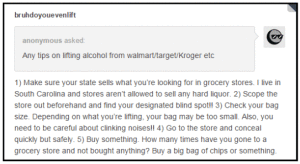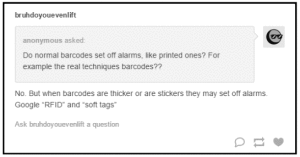 Experts agree that shoplifting can be reduced by having a trained team of employees and managers at the store. Shoplifting seminars or shoplifting prevention training can help reduce shoplifting at your store, and let you keep more of the profits. By training your employees you can avoid racial profiling, or at least mitigate it and avoid lawsuits that are costly for you. For more about this topic, follow the links below.
Experts agree that shoplifting can be reduced by having a trained team of employees and managers at the store. Shoplifting seminars or shoplifting prevention training can help reduce shoplifting at your store, and let you keep more of the profits. By training your employees you can avoid racial profiling, or at least mitigate it and avoid lawsuits that are costly for you. For more about this topic, follow the links below.
The black man arrested in Georgetown because he looked like a shoplifter
An hour after Bilaal Briggs clocked in for work at Sports Authority in Arlington on a mid-May morning, a tall African American man walked into Georgetown’s Zara. He grabbed some clothes and, when a manager spotted him, bolted out of the store. The manager called police and dispatched a warning on a private messaging app that hundreds of Georgetown retailers, residents and officers use to discuss people they deem suspicious in the wealthy, largely white community.
“We just got hit,” wrote the manager, Neetu Kaur. The description: “African American male 6’2 tattoos of stars on right side of neck and a tattoo of letters on the left side of his sideburns.”
Two days later, Briggs, who is black, 6-foot-1 and has tattoos of stars on his neck, arrived at Zara to buy a shirt he had placed on hold. The manager spotted Briggs, mistook him for the thief and called police. Within minutes, Briggs was in cuffs, wondering what had happened.
Police to start charging businesses for ‘excessive’ shoplifting calls
LANCASTER, Pa. (WHTM) – Surveillance cameras keep a watch on anyone who walks into Keystone Fireworks in East Lampeter Township.
Business owner Kevin Shaub says that’s one of the reasons they’ve never had a problem with shoplifting.
“Our product, being that it’s generally a fairly large product, doesn’t lend it to be easily shoplifted,” he told ABC 27 News.
Township police told ABC 27 News they’re getting called to more than 300 reports of shoplifting a year and have been burdened by the amount of shoplifting calls from retailers.
That’s the reason behind a new ordinance which calls for business owners who make “excessive” shoplifting calls to pay police.
Businesses who call officers more than 10 times a month will have to pay $250 for each call.
Stores using app to detect shoplifters accused of racial profiling
Some businesses in an upscale Washington, D.C. neighborhood are accused of racial profiling through a mobile app that allows shopkeepers to alert each other — and police — through private messaging about people acting suspiciously in their stores, reports CBS News correspondent Jeff Pegues.
In trendy Georgetown, store owners will tell you shoplifting is part of the cost of doing business.
“The type of people that is more like a shoplifter, they come here all the time, they go to that same item, they get the feel of the store,” said Keisha Green, an employee at the Sports Zone Elite.
In the last 60 days alone, police recorded more than 120 thefts in the heart of Georgetown.
To counter crime, businesses are using an app called GroupMe. It works like a private chat room, in which 380 members — including merchants, employees, community leaders and on-duty police officers — send each other descriptions and pictures of customers acting suspiciously.
But in Georgetown, where nearly 80 percent of residents are white and have a median household income of almost $120,000, the vast majority of the reports are about black customers.






 eir knowledge to others who may be new to the game. Much like a tenured LP manager taking a green agent under their wings.
eir knowledge to others who may be new to the game. Much like a tenured LP manager taking a green agent under their wings.



